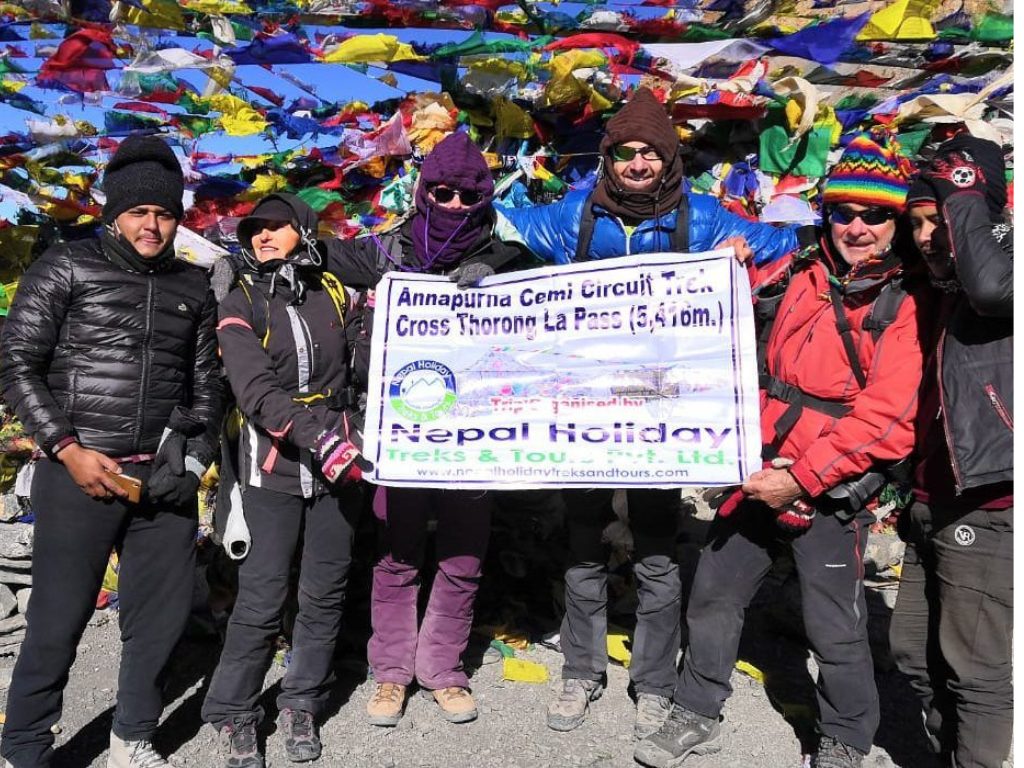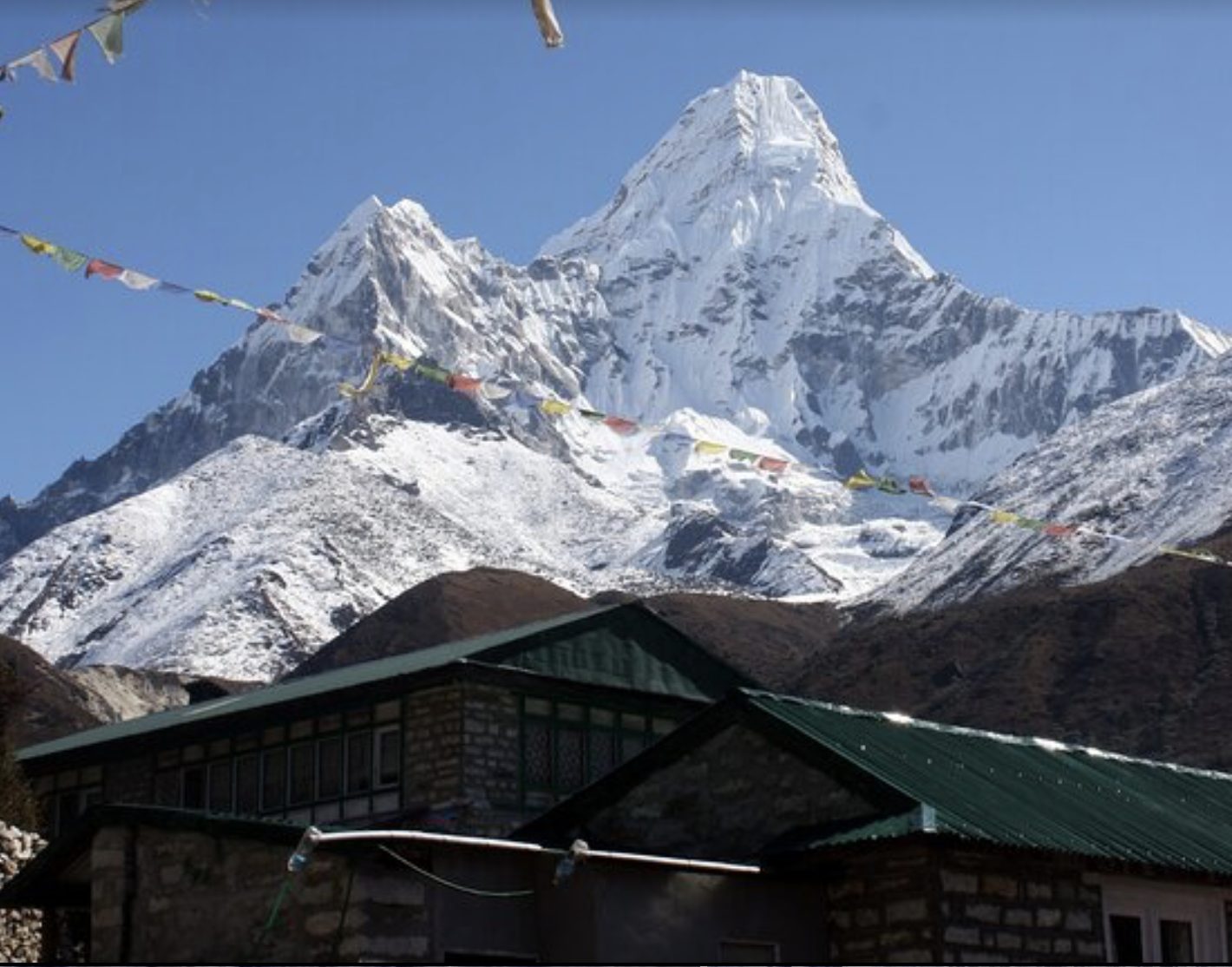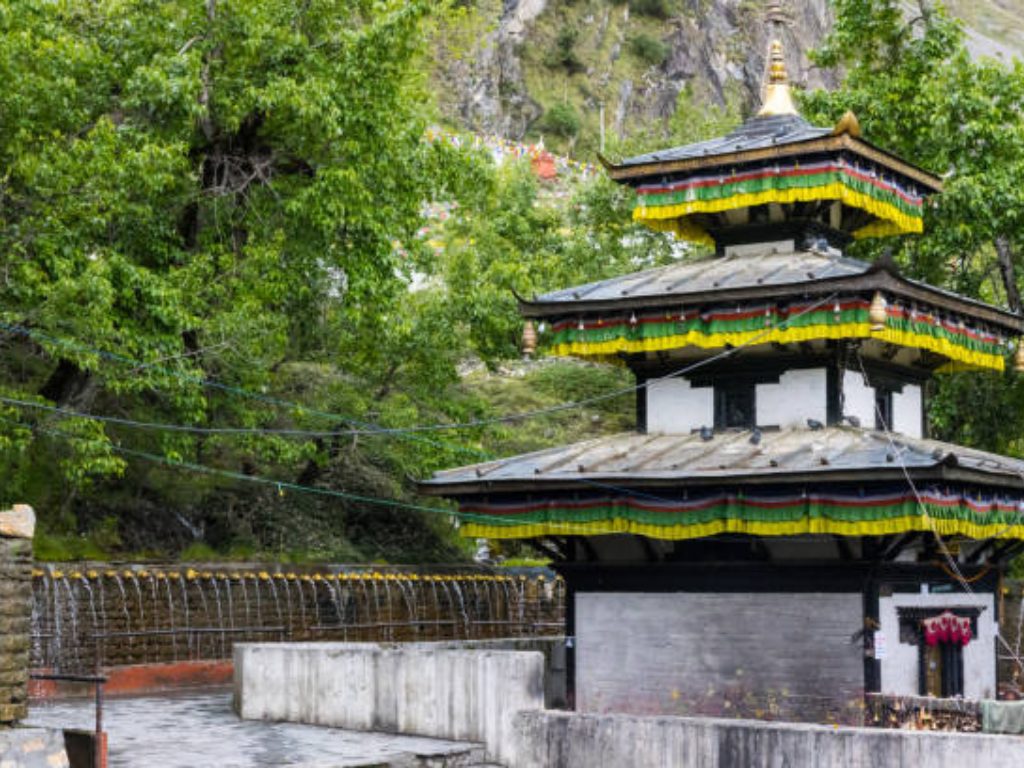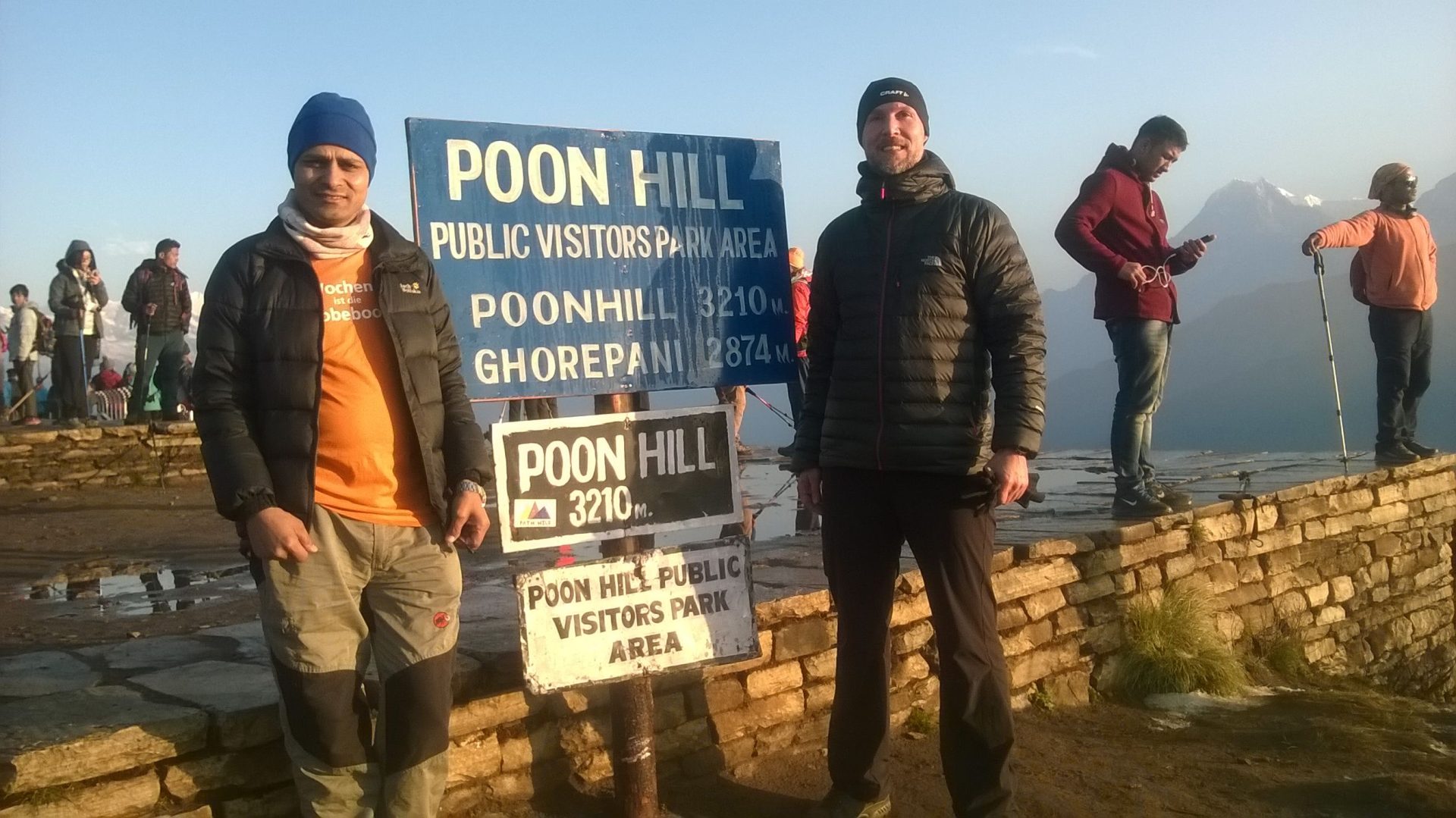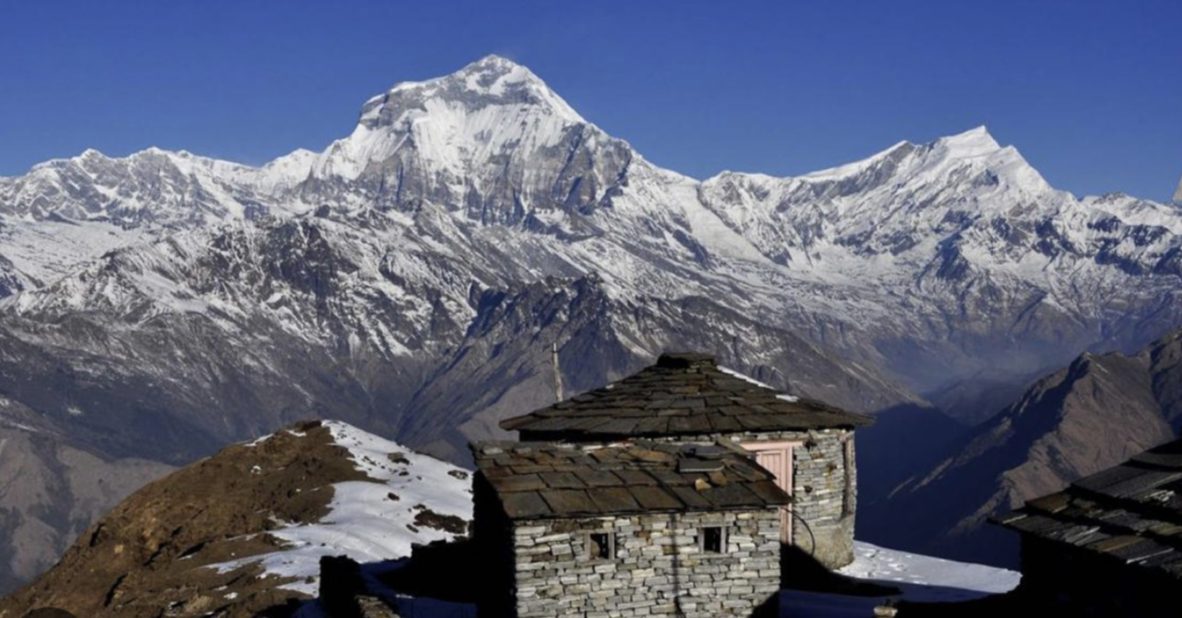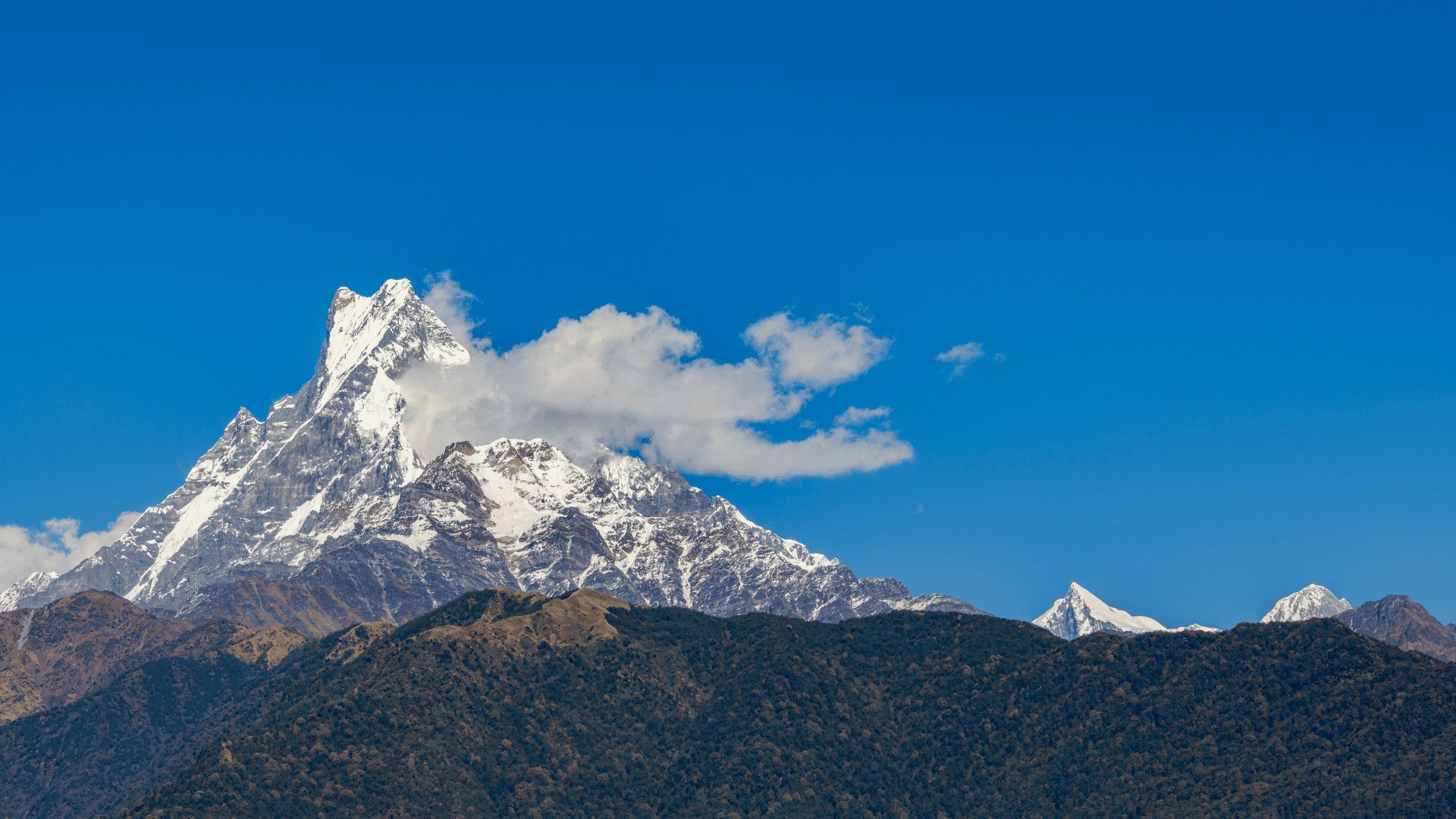Short Manaslu Tsum Valley Trek Overview
An 18 days trek, the Short Manaslu and Tsum Valley Trek engages trekkers to an adventure close to Mt. Manaslu (8163m), the eighth highest mountain, set off entirely through the mystical valley of Tsum. Manaslu is number 8 in the vaults of mountaineering.The place is Tsum Valley with a pilgrimage site, and together with that, the culture, tradition, and lifestyle being remained untouched by modernity makes this place alluring. In this trip, one would discover the ancient customs of Tibetan Buddhism, with the far-off extent of experiencing daily rituals and lifestyle in parts of Nepal, which they have known least of modernization. Manaslu Tsum Valley trekking is a mystical paradise of Buddhist temples and nunneries, spinning devotional wheels, and the deep-throated sound of long Tibetan horns thundering across the distances, one of Nepal’s greatest assets of diverse identity. It’s a cultivated patchwork of meadows and terraced fields that has the majestic Ganesh Himal for the breathtaking touch to this beauty and the light of its gentle populations bathed in their everlasting faith in the sanctity of all life.
Travel from Kathmandu to Machha Khola, where the trekking itinerary for the Short Manaslu Tsum Valley Trek begins. Now, you have to cross Budhi Gandaki and enter the village of Lapubesi passing through terraced fields and a few small villages. Tatopani also includes woods along with smaller villages and, finally, a hot spring bath where you can relax during the evening. The Short Manaslu Tsum Valley Trek takes you on a journey to Philim while beautiful views of Sringi Himal accompany you along the way. Chhokang Paro, Upper Tsum Valley after passing Chumling, is where you will reach; awesome view of Ganesh Himal, Boudha Himal, and Himal Chuli would be your welcome. Then you will also go to Piren Phu (pigeon cave) which is a sacred place with Buddhist paintings, inscriptions and carved stones on your way to Nile/Chhule where you will stop for exploring.
Afterwards, the journey goes to the Rachen Gompa, a nunnery. Your next stop will Mu Gompa at 3700 meters. The trek through Short Manaslu Tsum Valley takes you to Gumba Lungdang. Pine and rhododendron woods are complemented by the Siyar Khola. From there, you will unwind before heading to Ganesh Himal Base Camp. Early rise is a must since the journey to Lokpa doesn’t have good accommodation and services. The route from Lokpa leads to Ghap and runs through Gurung and Thakali villages to eventually reach Lho. You will stop at Samagaon and spend one more day visiting the village. Here you will gain altitude gradually to Samdo, Dharmasala, and finally Bhimtang where you cross the Larkya La pass which is up at 5160 Meters. Next, you will trek ahead to Dharapani from where you will take a Public Bus to Kathmandu, and this definitely marks your Short Manaslu Tsum Valley Trek Itinerary successfully.
Nepal Holiday Treks and Tours is professional in delivering the well-organized 18 Days Short Manaslu Tsum Valley Trek Itinerary. The itinerary also covers your arrival and departure days in Nepal. We are eager to share our local knowledge and stories and go the extra mile to provide a memorable and personalized journey through Nepal’s magnificent area. Contact us in case of any doubts regarding Short Manaslu Tsum Valley Trek Cost and Itinerary.
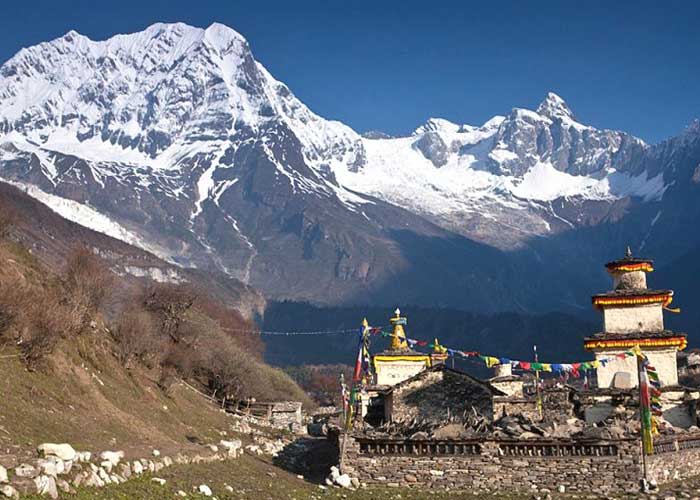
Best the Weather and seasons for Manaslu Tsum Valley Trek:
The best season to land on the Short Manaslu Tsum Valley Trek, route is indeed spring and autumn. During these seasons, the views of the majestic mountain ranges are vividly visible. March, April, May, September, October, and November fall in the spring and autumn season is best for a visit to Manaslu Region.
Autumn
The autumn season starts in September and runs till November. The season brings warm temperatures where the days are brighter and more favorable. It is also the best time to start hiking in the lower elevation to cross the challenging Larke la Pass (5,165m).
Autumn is one of the right times for you to pick for the trek. It’s autumn which is taken as the most liked trekking time in the Himalayas. Through this season, the surrounding remains at its best face. The view gets just cleared and washed by the Monsoon’s rain. You’ll experience some raindrops and clouds in Early September. And it’s entirely possible to do the Manaslu trek after the Mid-September all the way until late November. One can experience the blue and cloudless skies, mild temperature, and bright visibility in these months.
Spring
Nepal spring starts in March and ends in May. It is the best time for crossing Larkya la Pass. Spring season arrives just after the winter, so the cold temperature will disappear while warmer temperatures appear with the season.
Spring is generally regarded to be a season for trekking in most areas here in Nepal. With the dawn of spring, the Manaslu region sparkles with the majestic glow of the mountains surrounding the area, and the terrains are filled with the fresh smell of wild forests. During spring, the accommodation facilities are also ample, and the tea houses are also generally open. This season is, however, a bit colder than the autumn season but you will not consider that after experiencing the bright side of spring. It is a time of blossoming flowers and greenery. The various flowers around the forests will be at full stretch displays.
Summer
During the summer, it might be quite challenging to trek in the Manaslu Circuit. Although many tourists have gone on Manaslu Larke la pass trek despite this, the trekking might not be as fruitful as in the spring or the autumn season. There might also be occasional rainfall at the start of the season making the land wet, muddy, and slippery.
Accommodation and Food on Manaslu Tsum ValleyTrek:
The teahouses provide single rooms with attached bathrooms at lower altitudes. While climbing higher, greater limitations on provisions are found to arise. Mostly twin-shared accommodation with a common washroom is available. Breakfast, welcome dinner, and farewell dinner are included in the package in Kathmandu.
There will be two beds with mattresses, soft pillows, and warm blankets in the room. The range of food varies and Manaslu is well supplied for your needs. In teahouses, typical Nepali food, continental, Italian, Tibetan, and Indian food can all be ordered. All food will be cooked by the local cook by using local vegetables, so that taste would be real local.
Culture of Manaslu Tsum Valley Trek Region:
Manaslu area hosts a good number of different ethnic groups like the Gurung’s, Tamang’s, Sherpa’s, and Tibetans. They have different languages, customs, and traditions, which add to the culture in the region. They are counted among the biggest ethnic groups in the Manaslu area. Gurung are known for their bravery, hospitality, and strong cultural identity. They have a huge background of folk music, dance, and festivities. The Sherpa’s are famous for their mountaineering prowess and skills in trekking at high altitudes. Sherpa’s culture has a very special Tibetan Buddhism backdrop to it. Another factor to consider is the sheer influence that Tibetan culture has in the area in terms of the very fact that Manaslu borders Tibet. Most of the adopted Tibetan refugees in this area still preserved their language and various aspects of their religion, which is primarily Buddhism, and cultural practices” . Buddhism, particularly of the Tibetan Mahayana tradition. The monasteries and stupas as well as prayer flags dotted across the landscape act as reminders of the spiritual heritage of the place since the region is so rich in its spirituality. Celebrations of such festivals include Losar (New Year at the Tibetan calendar), Dumji (Festival of Gurung), and Tihar (Hindu festival of lights) amidst celebrations and gatherings by community members altogether. The traditional livelihoods of the people of the Manaslu region are mainly farming, livestock rearing, and trade. People are seen growing rice, barley, potatoes in terraces, whereas yak herding is mostly common at higher levels.
Altitude sickness during the Manaslu Tsum Valley trek:
Larke la Pass is one of the highest passes in Nepal also the highest destination of the trek. So altitude sickness among the trekkers is quite common during the trek. To prevent altitude sickness during the trek, it is essential to acclimatize slowly and avoid gaining too much altitude too quickly, especially above 3,000 meters. It is recommended to take a rest day after every few days of trekking to allow the body to adjust to the altitude. Drinking plenty of water, eating high-energy snacks, and avoiding alcohol and smoking can also help prevent altitude sickness. Taking medication, such as acclimatization, can be helpful in preventing and treating altitude sickness symptoms. Trekkers can also take medication like Diamox for altitude sickness.
Preventing Altitude Sickness (AMS):
- Rest Well: Ensure that you rest well and physically fit before starting your trek.
- Stay Hydrated: Drinking plenty of water during the journey is very necessary.
- Balanced Nutrition: Maintain the balance of salt and sugar through proper eating habits and not skipping meals, also eat about 4500-5000 calories daily.
- Keep Warm: Layer up to remain warm without profuse sweating, bring adequate clothes.
- Controlled Breathing: Breathe deeply and steadily to maximize lung capacity. Maintain a comfortable walking speed that will allow for controlled breathing. Nasal breathing avoids drying your throat wearing a muff or scarf in high altitudes.
- Pace Yourself: It’s not a competition. Maintain your pace, walk slowly rather than fast and taking rest frequenlty which will make you less tired and easier, walk admiring the stunning views.
Level of difficulty of crossing Larke La Pass:
The trek for the Larke La Pass can differ in level of difficulty depending on weather conditions, time of the year, individual fitness, and acclimatization.
Standing at an elevation of about 5,106 m (16,752 ft), Larke La is quite high for elevation sickness to become a possibility, and good acclimatization should reduce such a possibility. Gaining the pass involves steep ascents and descents over rocky terrain with narrow trails going through loose screed and maybe some snow cover. All these factors imply that the trek can be physically demanding and requires good balance and stamina.In the Himalayas, weather can also be pretty erratic with rapid changes. Higher up, trekkers can expect to encounter snow, strong winds, and freezing temperatures. Snow and ice cover may render the trails slippery, adding another layer of difficulty in traversing potential trails.The Manaslu Circuit Trek, including an attempt to cross the Larke La Pass, takes normally around 14-18 days. The long duration of the trek requires a keen level of fitness and stamina to maintain hiking for several back-to-back days at high altitude. The Manaslu area is far more remote than other famous trekking destinations like Everest or Annapurna. Thus, while some lodges and medical services may be found along the trail, trekkers should be self-sufficient and prepared for very long days.
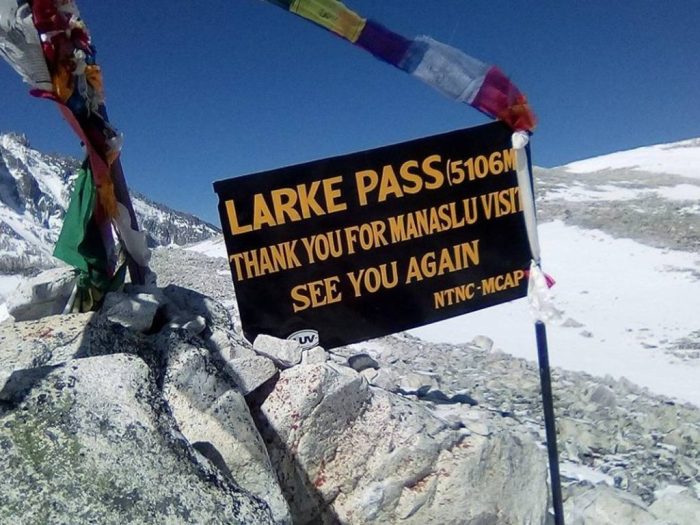
Guide and Porters for the safety on Manaslu Tsum Valley Trek:
According to Nepal tourism board all the trekking activities should be conducted along with a government licensed guide and porter. Its compoulsary to hire a guide for Short Manaslu Tsum Valley Trek as it falls under restricted area, solo trekkers are prohibited. Your safety is our first priority. So our guide and porter are dedicated to making your experience of Trekking in Nepal a memorable one without compromising your safety. Along with your safety we also focus on our guide and porter safety too. Notably, our guide and porter are provided with insurance facility. Porter will carry up to 10 kg or 15 kg per client. Also one porter is for 2 people, more can be added as per your requirement. If you wish , you may keep your clothing and items in a storage on room where you are stay on Kathmandu hotel.
Preparation for Trekking in Manaslu Tsum Valley Trek:
Nepal Mountain trekking takes endurance and strength, both of which can be worked on through frequent exercise. Therefore, we encourage you to exercise regularly, creating a habit of going hiking, running, or going to the gym, as much as possible before visiting the trekking site for this adventure. Walking, running, swimming, and biking will help in five-day workouts as the body will learn to regulate its breathing patterns. Prepare with a set hike of 5 to 7 hours on local routes or short hills with minimal breaks to prepare for the Manaslu Tsum Valley Trek. This trek in fact requires quite a lot of things to be done such as conditioning, gears, and logistics.
Physical Fitness: The Short Manaslu Tsum Trek is challenging; therefore, you will need to be in good physical shape to appreciate it entirely. The walking involved is usually several hours over high altitudes across steep and rocky terrain every day. For this, training needs to start some months in advance with cardio exercises that include but are not limited to swimming, running, or cycling, and also strength building for legs and core. Gear: You will need good quality backpack, comfortable hiking boots, appropriate clothing, and a myriad of other gear including a sleeping bag, camping equipment, a stove, headlamp, sunglasses, sunscreen, hat, and gloves. Just to mention a few. Make sure you have enough gear or you can also rent it in Kathmandu.
Logistics: The Short Manaslu Tsum Valley Trek requires a special trekking permit and a government-appointed guide. It is always good to do your arrangements for trekking well ahead of time because of limited permits and also the most difficult process in getting them. Also, book in advance a guide and a porter, if you want one. Finally, we suggest that you put up an insurance policy that has an emergency evacuation feature since the trek goes through isolated places where it is hard to access any form of emergency medical care. Remember as well the acclimatization schedule to avert altitude sickness and other illnesses. As can be seen, the Manaslu Tsum Valley Trek proves to be a lovely trek and is full of adventure and wonderful memories. However, preparation and being well informed will lay the basis for such an event to be a safe and enjoyable one.
Regulations and Permits for Trekking in Manaslu Tsum Valley Trek:
One of the beautiful but demanding treks that one has to plan thoroughly is Short Manaslu Tsum Valley Trek. It is a complicated trek with lots of permits as Short Manaslu Circuit Tsum Valley Trek falls under the restricted area. It is meant to protect place cultural values and natural beauty. Below is a very concise guide on permits requirement and procedures of obtaining them, including important rules for smooth and legal trekking.
- Manaslu Restricted Area Permit (RAP).
- From September to November:
- USD 100 per person for the first 7 days;
- USD 15 per person for each individual day thereafter.
2. From December to August:
- USD 75 per person for the first 7 days:
- USD 10 per person for each individual day thereafter.
2. Tsum Valley Restricted Area Permit:
- September to November:
- $40 per person for the 1st 7 days;
- $7 per person per day thereafter.
2. December to August:
- $30 per person for the 1st 7 days;
- $7 per person per day thereafter.
3. Manaslu Conservation Area Permit (MCAP)
- Fixed Cost:NPR 3,000 (approximately $30).
- Annapurna Conservation Area Permit (ACAP)
- Fixed Cost=NPR 3,000 (approximately $30).
These permits are a must-have for anybody on the way to Short Manaslu Tsum trek, as they contribute to conservation and sustainable tourism in the area.
Permit Acquisition Process
These permits are not an individual affair but require collective coordination through Nepal Holiday Treks and Tours. Trekkers cannot obtain these permits independently as the area is restricted.
Required Documents
Passport Copies: A duly cleared copy of the identification page of your passport.
Passport-Sized Photograph: Four recent photographs to document permits.
Travel Insurance Details: Proof of travel insurance that covers high-altitude trekking with emergency evacuations.
Processing Time
Nepal Holiday Treks and Tours handles the requirements for processing permits, which take generally a few working days. Providing all necessary documents well in advance assures timely processing and regulation with your Manaslu Tsum Valley Trek itinerary.
Regulations
In a bid to maintain the sanctity of the Tsum Valley Manaslu Trek while organizing the safety of all trekkers, the Nepalese government has developed various regulations:
Mandatory Licensed Guide:
He/she should be accompanied by a licensed guide or porter. This makes trekking safer and creates local job opportunities.
Minimum Group Size:
Minimum number of trekkers: two Minimum to trek alone: Does not happen in the prohibited area.
Checkpoints:
All the permitted points mark a check within the Short Manaslu Circuit Tsum Valley Trek. Thus, ensuring the availability of all the permits at all times would help avoid a possible delay or fine.
Respect Local Laws:
Everyone should respect every rule created by the Nepalese government and other local authorities, taking in culture, touch, environmental conservation, etc.
Short Manaslu Tsum Valley Trek Highlights
- Manaslu (8163m), the eighth highest mountain peak in the world, is located in this region.
This region is much more ethnically diversified with Brahmin, Chhetri, Tamang, Magar, Tibetan, and Gurung people residing here. - The area features pine, oak, spruce, and the lovely rhododendron forests, including some habitats for endangered wildlife including the endangered snow leopard and red pandas.
- Of course, and the Tsum Valley is one of these hidden treasures worth coming to visit.
- For a beautiful experience, there are options for tours to such places as Gumpa Langdang, Ganesh Himal Base Camp, Kal Tal, the Tibetan border, Pungen Gumpa, and Manaslu Base Camp.
- The most interesting peaks include Mt. Manaslu (8163m), Machhapuchhre (6997m), Gangapurna (7455m), Annapurna I (8091m), Annapurna South (7219m), and Annapurna III (7555m) were among the peaks highly visible from this location.
- Fine blends of Budhi Gandaki River Valley with Nepalese and Tibetan cultures, histories, and ways of life.
The trails are less traveled, and the most spectacular views one can ask for from the mountain. - A truly spiritual atmosphere with such ancient and magnificent Gompas as Rachen Gompa, Mu Gompa, Gumba Lungdang “and many more”.
Short Manaslu Tsum Valley Trek Itinerary
Expand allDay 1: Pick up from airport- transfer to hotel- trip meeting at office:
At the Tribhuvan International Airport, you will be greeted by our Airport Representative. A private tourist car will take you to the hotel. Rest or visit us at our office for details on the Manaslu Tsum Valley Trek Itinerary.
As soon as you reach the hotel, we can set up the appointment for the trip meeting. The trip meeting will take place at the office of Nepal Holiday Treks and Tours.
Day 2: Public Bus from Kathmandu (1400m) to Machha Khola (890m):
After an early breakfast, your Manaslu and Tsum Valley journey will begin with the public bus to Machha Khola through Arughat and Soti Khola. The bus ride will offer you a glimpse of amazing views of Annapurna, Manaslu, Ganesh Himal, and Langtang Himal. You will reach Machha Khola after crossing Gurung and Magar villages, farmlands, and waterfalls.
By crossing another lovely suspension bridge you will reach The Sal Forest. Next,
There is a steep hill above the Budhi Gandaki which lies in the jungle. You may enjoy the beautiful rice fields scattered along the way to Labubesi village. Ultimately, you will reach Machha Khola village, where you will be resting and preparing for the next day’s adventure.
Day 3: Trek from Machha Khola (890m) to Jagat (1340m)
A series of ups and downs, the Manaslu with Tsum Valley Trekking route, makes this quite difficult. From Machha Khola through Tharo Khola upp to another small picturesque Gurung village, Khorlabesi. Another short but steep climb takes us to Tatopani, the hot water spring, where we spend some time soaking in the natural sauna. After crossing the Budhi Gandaki River over the suspension bridge and climbing up the staircases, you will reach Doban.
The Yuru River is crossed by Yaruphant. In Yaru Bagar, you’ll cross the Cantilever bridge, which was built with Swiss Technology in 2016 after an earthquake. You will then cross the Budhi Gandaki River to the west of the village and then hike over the hill and descend down to the river to Jagat village. At Jagat, permits will be registered at a police checkpoint since this is the access point for the Manaslu Conservation Area.
Day 4: Jagat (1340m) to Lokpa (2240m)
Jagat is an extensive Gurung settlement found in a saddle within a plain. Upon passing this agro-based village, the trail will climb onto a rocky ridge above Salleri, providing good views of Mount Sringi. Upon reaching Sirdibas and getting cultural insights into the old Buddhist settlement, you will cross the longest suspension bridge of Nepal and further climb to Lokpak situated on the northern site of Philim.
After about an hour of climb, you will reach Ekle Bhatti; from there, it is a gradual climb through a wooded area. The Manaslu and Tsum Valley Trek aveu- ascends through the pine trees along one end of a grand canyon, as you reach near a junction. You will then want to take the right-hand trail toward Tsum Valley, where you will stay overnight at Lokpa. From Lokpa village, you will enjoy breathtaking views of Himalchuli and Boudha Himal.
Day 5: Lokpa (2240m) to Chumling (2386m)
The trail passes through a completely silent tropical rhododendron and pine forest. A few ups and downs will take you to a small suspension bridge. This small swinging bridge leads to Ripchet and Chumling from where the Manaslu with Tsum Valley Trekking trail has been diverted. Cross the bridge down the path to pass a small stone wall. There is a monastery at the very top of the village of Chumling where you can then view Ganesh Himal. Panago Gumba, Mani Dhungyur, and Gurwa Gumba are three of Chumling’s monasteries. The visibility of the minor valley is increased due to the placement of a great Chorten in the center of the field.
Day 6: Chumling (2386m) to Rachen Gompa (3240m):
From Chumling, the direction is across a suspension bridge towards the other side. From Domje, this Manaslu Tsum Valley Trek route follows Syar River downward. Now to reach Chhokang Paro, one has to keep climbing up to Domje. Gho Village, which has a small local teashop, is reached by traveling through Rainjam onto another bridge. The beautiful traditional village of Chhokang Paro is reached after further trekking for two hours to Tsum.
Best views of Himalchuli and Ganesh Himal to the distance on a clear day from Chhokang Paro. Then converging to Lamagaon and then Rachen Gompa, which will be the destination for today from Chhokang Paro.
Day 7: Rachen Gompa (3240m) to Nile (3361m) and to Mu Gumpa (3700m):
After breakfast, wake up to the marvelous vistas of the Nile with scenic walks from the Rachen Gompa. At the Nile, lunch will be served. After lunch, leave your heavyweight travel items in the tea house and go for a day trip to Mu Gompa. The Manaslu with Tsum Valley Trekk elevation sweeps up incredible trails and reaches Mu Gompa, the largest monastery in the Tsum Valley and the highest altitude in the Tsum Valley. A flat, bowl-like valley encircled by mountain peaks will greet you in Mu Gompa, one world in its universe.
There aren’t any tea houses or accommodation facilities in Mu Gompa. Those wishing to spend the night would have to stay in the Monastery, where the spaces are limited. Thus one will come back to the Nile after a visit to Mu Gompa.
Day 8: Nile (3361m) to Chumling (2386m):
While enjoying the Manaslu and Tsum Valley Trekking Trail, you will head towards Chhule, and then onwards to Phurbe, where you will enjoy a comfortable stay in the Sherpa home. Proceeding from there, the way to Rachen Gompa, a beautiful nunnery, continues along the banks of the Siyar River, passing through flat meadows, and via the gripping sights of the power lines. The view of Kipu Himal is splendid if the skies are clear on the way to Rachen Gompa. Continuing along this route, you will go through Chhokang Paro, Domje, Kowo, and on to Tanju before reaching your destination-Chumling, where you will overnight today.
Day 9: Chumling (2386m) to Deng (1860m):
After the suspension bridge, cross a long downhill trek from Chumling to Lokpa village. The Manaslu Tsum Trek begins on rocky hills, where a hint of Sringi Himal can be spied some distance away. You will be walking along the Shair Khola’s bank. The trail will let you enjoy spectacular views of the Ganesh Himal, Manaslu, and some other snow-covered peaks of the region. You will proceed past Ghatta Khola and on farms, where maize, millet, potato and other vegetables are raised. This crossing passes through bamboo trees; Deng River will be reached after crossing through an empty canyon trek on pathways along the bank of Budhi Gandaki.
Day 10: Deng (1860m) to Namrung (2630m)
On this day, you will begin your Manaslu Tsum hike from Deng to Namrung. Climb from Deng to Rana Village and then walk on toward Bhiphedi. The views on the trek are wow: Sringi Himal and Budi Gandaki River multiple times. The trail moves in and out of valley canyons passing by Serang Khola into Ghap. Leaving Ghap, the valley becomes steep as you climb past bamboo and rhododendron.
After crossing some wild rivers, you might reach Namrung Village, the gateway to Upper Nuri. Tibetans settle in Upper Nuri. They speak a distinct dialect.
Day 11: Namrung (2630m) to Lho (3180m):
The trail ascends steeply from Namrung to Lihi following Tsum-Manaslu trekking route. It offers breathtaking views of Himal Chuli and Ganesh Himal. From Lihi, the road leaves for the Simnang side valley and then the Hinang River. A chorten along the river shows Ngadi Chuli. You will move on to Sho after that. The path now ascends to Shrip. On your way to Shrip, you will come across a gigantic prayer wheel. The ridge where Lho village is located is reached after a difficult hike.
It is visible for the first time from the settlement, Manaslu North and Naike Himal. Ribung monastery is a local monastery just above Lho hamlet. A nice spot to view sunset or sunrise is also a place called Kani near Lho village. One can hike to Kani for the sunset in the evening. If you wake up early enough, you can catch the sunrise above Manaslu Himal.
Day 12: Lho (3180m) to Samagaon (3520m).
The village of Shyala is not anything but a on-the-job break between Lho and Samagaon. The Manaslu Tsum Valley Trekking Route will cross through several gompas and Tibetan settlements while at the same time dotting alpine scenery and slopes with wonderful views toward Mount Manaslu. You will equally learn about the cultural landscape of the region. From the view of a trekker, Ribung Gompa is well worth hiking up to. Visitors will be awestruck by glorious views of soaring glacier-age mountains.
Birendra Lake and Pungyen Gompa are one option, while a visit to the nearby glacial moraine would be another. If you’d rather spend a more relaxed day visiting the sights than anything else, be sure to check out Pungyen Monastery, situated just beneath Manaslu’s east face. Up at the edge of town, one can also visit the cave Gompa and hot springs.
Day 13: Acclimatization Day at Samagaun-birendra lake or Pungen Monastery or Manaslu Base Camp
We strongly advise you to spend at least one day in Samagaon acclimatizing. You can then hike easy after dropping off your luggage at the teahouse, which is good for acclimatization. Hoilect this day-long acclimatization will present you with lovely walks. First, Birendra Lake next to Punhyen Glacier: Here is the freshwater lake at an attitude of 3,450 meters. It is just a three kilometers journey from Samogaon itself to reach the lake.
Manaslu Base Camp-the eighth in the world of tallest mountain base camps-can be reached by trekking. It is located at an altitude of about 4,800 meters-at a distance of nearly from the village 6. Now let’s move on to the third one, the Pungen Monastery, which is 6-7 km away from the settlement. Everything about a monastery, with peaks, prayer flags, and mani walls, can be seen facing this peaceful and beautiful trek. An attempt should be made to visit all the places on this day. One, two, or even more of them can be visited if not all. Finally, in the evening, hike back to Samagoan.
Day 14: Samagaon (3520 m) to Samdo (3860 m)
From Samagaon, you have to trek high up to reach Samdo along a climb on an isolated track. The Manaslu Circuit Trekking path wanders next to the Budhi Gandaki River and through a wonderful woodland of Rhododendron, Juniper, and Birch trees. The valley then opens up, and before you reach Kermo Kharka and the ivory-white gateway of Kani, the path takes you through mani walls parlancing the path. Continue on and reach Samdo, a mere 4 kilometers north of the Tibetan border. Views from here include: Mount Manaslu, Simnang Himal, Ngadi Chuli, Manaslu glacier, Manaslu icefall, among other peaks of the Himalayas. Plus, there is a sort of Tibetan refugee community.
Day 15: Samdo (3860m) to Larkya Phedi (4480m)
The views with Larkya Glacier on one side and the great Manaslu Mountain on the other are just spectacular for today. You will settle at Larkya La Phedi and prepare for the crossing of the Larkya La Pass tomorrow. The trek continues in the Manaslu Tsum Valley through hills and over wooden bridges across the Budi Gandaki. After crossing the two streams, you reach the Larkya glacier through a beautiful valley. You then climb through the Salka Khola Valley and then back to the Dharmasala or Larkya La Phedi-the stone rest house, but here it is not called a lodge. It is a type of resting place. The day’s trek is quite short, so you’ll have plenty of time to acclimatize to the elevation.
Day 16: Larkya Phedi (4480m) to Bimthang (3720m) on Harrowing Larkya La Pass (5160m)
Trekking across this longest and hardest stretch requires getting out of Dharmasala by starts early in the morning. The Manaslu Tsum Trek begins by an easy incline over the moraines. From there, it will gradually descend towards the lake before becoming rough and vague by steep grassy hill caps. After going down to the four frozen lakes, you will meet the last arduous climb up to the pass. You get to see from the pass the views of Himlung Himal, Cheo Himal, Kanguru, Minjung, and the mighty Annapurna II.
The route follows the crest of the moraine to the west, joining it with a series of steep rugged switchbacks, before descending more gently on loose gravel to another grassy moraine. The trail becomes less complicated and leads to a tiny meadow at this point. As trails descend to a large meadow at this point, passing a mani wall and a little resting hut marking Bhimtang, it is here that the valley begins to widen.
Day 17: Bimthang (3720m) to Tiliche (2560m)
As per Manaslu Tsum Valley Trek Itinerary, this is the final day of trekking in the Manaslu region. From Bimthang, descending through high-grazing grassland, Dudh Khola, and rhododendron woodland, one can view Manaslu, Lamjung Himal, Himlung Himal, and Cheo Himal. At the outset, having passed by Dobhan and Purdi Khola, one will descend from Bimthang to Hampuk village. Thereafter, towards Gho Village, you will traverse Yak Kharka and Kharche, and the beautiful streams Soti Khola and Kasongto Khola. After crossing Gho village along the bank of the river, you will arrive at Tiliche
Day 18: Return to Kathmandu (1400m) or Pokhara (822m), departing from Tiliche (2560m).
Well, this is the end of Tiliche for you, and you will catch a shared jeep to Besi Sahar. You will take a lifetime of memories, as well as photographs of some of the world’s most beautiful mountains, to home. You can use a public bus to go to either Kathmandu or Pokhara from Besi Sahar. You will spend that night in Kathmandu or Pokhara celebrating your conquest of the Manaslu Tsum Valley Trek with a farewell supper for sharing memories.
If the above Everest Base Camp Trek itinerary does not meet your needs, we can design individualized travel plans based on your preferences and specifications.
Plan My TripShort Manaslu Tsum Valley Trek Cost Includes
- Airport pickup and hotel transfers by private Vehicle.
- Three times Three meals a day- Breakfast, Lunch, Dinner and 3 cup’s of tea/Coffee a day during the trek.
- Accommodation in tea house during the trek.
- In a day time tea break with cookies every day.
- Seasonally fruits and desserts on the trek after dinner every day.
- You will be under observation with a pulse oximeter to have your oxygen levels and heart rate measured twice a day during the trek. This is to catch the signs of Altitude Mountain Sickness (AMS) early, thus making trekking safer.
- Nepal Holiday Treks and Tours, (-20 degree sleeping bag) and a duffel bag for the trekking, but you need to refund to the office after the trip.
- National park Trekking permits & local government permit and TIMS Card.
- All special permits required for Manaslu and Tsum region.
- 3 nights accommodation in Kathmandu (3 Star) on the BB plan, 1 night before starting the trek and 1 night the day after returning from the trek.
- An experienced, helpful, knowledgeable, friendly, English speaking well trained, government license holder Trekking Guide with all his salary, food, Drinks, accommodation, equipment, transport, and insurance.
- Normal First aids kit box
- Nepal Holiday Treks And Tours trip completion certificate from the company side.
- Arrangement of Emergency helicopter service (paid by your travel insurance company)
- All the government taxes and company operating charges
Short Manaslu Tsum Valley Trek Cost Excludes
- International airfare and visa fees
- Extra days in Kathmandu and the mountains such as weather condition, flight delays, or strikes and health issues.
- Lunch and dinner in Kathmandu
- Equipment (sleeping bag, down jacket, and trekking pole)
- Personal expenses of bar and beverage (bills, WiFi, hot shower, extra porters, laundry, extra porters etc) or any other things which are not mentioned by the company.
- Travel insurance along with high-altitude emergency evacuation coverage.
- Your trekking gears and extra nights in a certain destination.
- Tips for your guide and porters which is comparison.
- A strong, helpful, porters with proper safety equipment and walking equipment his salary, food, drinks, accommodation, insurance, (one porter for two people he will carry bag pack max 20-25kg).
- Extra expenses due to any event
Upcoming Departures
Customer Reviews
Write a ReviewShort Manaslu Tsum Valley Trek Equipment Lists
General info:
- Sleeping Bag and duffle bag: Four-season sleeping bag with a rating of -20°C by company after you have to refund on company.
- Insulated Jacket: A puffy and warm down jacket suitable for winter by company after you have to refund on company.
- Daypack: 25-30 liter backpack rain cover to carry one’s daily essentials
Clothing:
- Thermal base layers
- Trekking shirts (quick-dry)
- Fleece jacket and down jacket
- Waterproof jacket and pants
- Trekking trousers
- Gloves (inner and outer)
- Warm hat and sun hat
- Trekking socks
Footwear:
- Sturdy trekking boots
- Camp shoes/sandals
- Gaiters (optional)
Accessories:
- Trekking poles
- Backpack (50-60L) and daypack (20-30L)
- Sunglasses (UV protection)
- Headlamp with extra batteries
- Water bottles and purification tablets
Similar Tours
Gokhyo-Renjola Pass trek
Gokhyo-Renjola Pass trek Your getaway from the typical trekking route to Everest Base Camp is the Gokyo Renjo-La Pass...
Jomsom Muktinath Trek
Nepal is a stunning country in the Himalayas with magnificent mountains. These mountains’ foothills make for ideal walking terrain....
Ghorepani-Poonhill-Ghandruk Trek
The sheer grandeur of Nepal’s many landscapes and geographical features makes it unimaginably beautiful. There are many interesting, quaint,...
Khopra Danda Trek with Khayer Lake
One of the most beautiful trekking routes in the Annapurna region is the Khopra Danda Trek. For trekkers who...
Machhapuchhre Model Trek
Machhapuchhre Model Trek could be an awesome alternative to the popular Annapurna Circuit. So, for all those trekkers who...

